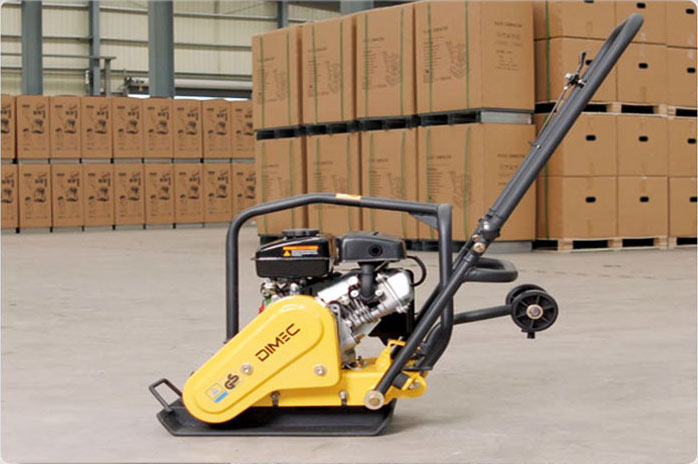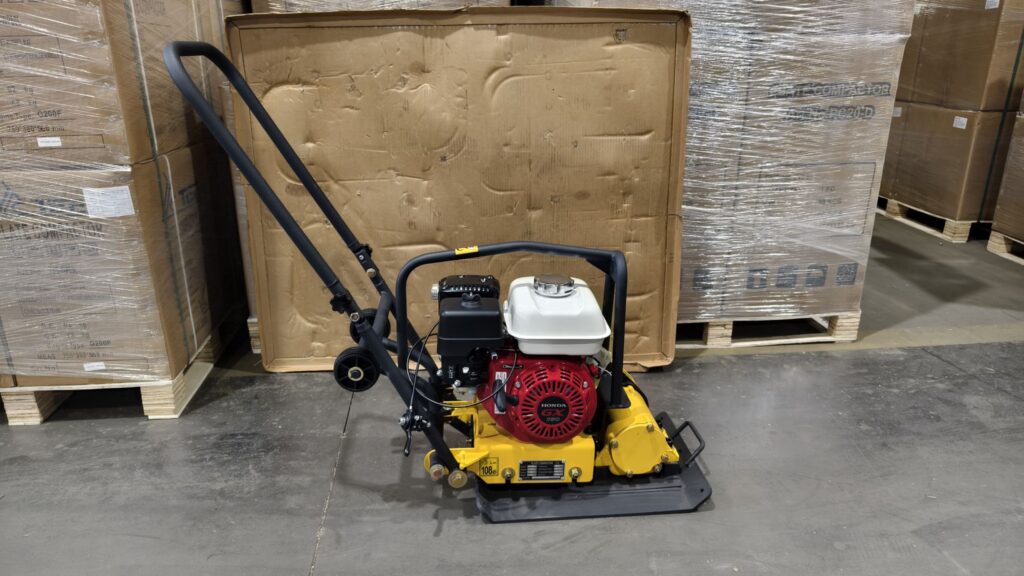Plate Compactor PME‑C50 vs Compactor Plate PME‑C60: In-Depth Product Comparison
- DIMEC
- Compactor Plate, Plate Compactor
- 07/02/2025
Home » Plate Compactor PME‑C50 vs Compactor Plate PME‑C60: In-Depth Product Comparison

Table of Contents
Soil compaction is a critical step in construction and landscaping projects. In this comparison, we’ll take a close look at the Plate Compactor PME-C50 and the Compactor Plate PME-C60 to help you make the right choice.
Technical Specification
| Model | Plate Compactor PME-C50 |
|---|---|
| Engine | Loncin LC152F |
| Engine type | Air-cooled, single cylinder, 4-stroke, petrol engine / diesel engine |
| Frequency [VPM] | 5200 |
| Centrifugal force [KN] | 9 |
| Plate size (LxW) [cm] | 43x31 |
| Max.compaction depth[cm] | 20 |
| Travel speed [m/min] | 20 |
| Max.inclination angle | 20 |
| N.W./G.W. [kg] | 54/58 |
| Package (LxWxH) [cm] | 69x38x53 |
| Model | Compactor Plate PME-C60 |
|---|---|
| Engine | Honda / Robin / Loncin / Diesel engine |
| Engine type | Air-cooled, single cylinder, 4-stroke, petrol engine / diesel engine |
| Frequency [VPM] | 5600 |
| Centrifugal force [KN] | 12 |
| Plate size (LxW) [cm] | 50x36 |
| Max.compaction depth[cm] | 28 |
| Travel speed [m/min] | 25 |
| Max.inclination angle | 20° |
| N.W./G.W. [kg] | 65/70 |
| Package (LxWxH) [cm] | 75x38x56 |
1. Plate Size and Compaction Force
The Plate Compactor PME-C50 features a 43 x 31 cm cast iron base plate. This plate size is optimized for precision compaction in smaller areas. It generates a centrifugal force of 9 KN, which is sufficient for tasks like compacting soil for residential driveways, patios, and small garden paths.
The Compactor Plate PME-C60, on the other hand, has a larger 50 x 36 cm plate. This increased plate size results in a higher compaction force of 12 KN. It’s ideal for large-scale projects such as extensive roadways, large parking lots, and high-traffic commercial areas, where a deeper and more uniform compaction is required.
2. Engine Power and Efficiency
The PME-C50 is powered by a 2.5 HP Loncin LC152F engine, with petrol and diesel options available. This engine provides reliable power for medium-duty compaction tasks. It’s suitable for projects where speed is not the primary concern, but precision and versatility are key.
The PME-C60, however, offers more power. It can be equipped with a 5.5 HP Loncin G200F engine or a Honda GX160 engine. This extra power allows for faster compaction over larger areas and deeper soils. In a large-scale construction project in [City Name], the PME-C60 reduced the compaction time by [X] days compared to using a smaller machine, thanks to its powerful engine and larger plate.
3. Vibration Frequency and Compaction Speed
The PME-C50 operates at a vibration frequency of 5200 VPM. This frequency is well-suited for most residential and small commercial applications, ensuring a uniform compaction.
The PME-C60 has a higher vibration frequency of 5600 VPM. Coupled with its larger plate, it can achieve a higher compaction capacity, up to 380 m²/h. This makes it a great choice for projects where time is of the essence and large areas need to be compacted quickly.
4. Applications
For residential and light commercial projects, the PME-C50 is an excellent choice. Its compact size and maneuverability make it easy to use in small spaces. It’s perfect for DIY enthusiasts and small-scale contractors working on projects like building a small patio or repairing a local driveway.
The PME-C60 is designed for heavy-duty and high-volume work. It’s ideal for large road construction projects, large-scale paving, and areas with heavy traffic. Its ability to achieve deep compaction and cover large areas quickly makes it a favorite among large construction companies.
5. User-Friendly Design and Maintenance
Both machines are designed with the operator in mind. The PME-C50 has a low-vibration system and ergonomic controls, reducing operator fatigue during extended use. The PME-C60 also features advanced shock absorption and user-friendly controls, making it comfortable to operate even during long hours of heavy-duty work.
Maintenance is important for both machines. The PME-C50’s robust build and high-strength components ensure durability, and regular maintenance like checking the engine oil and air filter keeps it in good condition. The PME-C60, built for heavy-duty use, has components engineered to withstand higher forces, and routine maintenance is essential to keep it performing at its best.
6. Cost-Effectiveness
The PME-C50 offers great value for smaller projects. Its reliable performance without excessive power means you’re not paying for more than you need. It’s a cost-effective option for small contractors and DIYers.
The PME-C60, although it has a higher initial cost, can be more cost-effective in the long run for large projects. Its ability to complete jobs faster reduces labor costs and overall project timelines, providing a higher return on investment.
7. Interactive Section
Do you have any questions about choosing between the PME-C50 and PME-C60 for your project? Leave your questions in the comments below, and we’ll do our best to answer them. If you’ve used either of these machines, share your experiences and tips with other readers.
In summary, the choice between the Plate Compactor PME-C50 and the Compactor Plate PME-C60 depends on the scale and nature of your project. Consider your project requirements carefully to make the best decision.
Plate Compactor X Tamping Rammer X Road Roller
Feel free to contact us for any questions and doubts
You May Also Like
Compactor Plate PME-C60 vs Machine Compactor PME-C80: Unraveling the Optimal Choice for Your Projects
Table of Contents 1. Introduction In the bustling world of construction and soil compaction, selecting the right equipment is no small feat. It can be the deciding factor between a project that progresses seamlessly and one that faces numerous setbacks. The Compactor Plate PME-C60 and Machine Compactor PME-C80, products of Wuxi Pinnacle Mechanical Equipment Co., Ltd., each come with their own set of unique advantages. This detailed exploration is here to help you figure out which of these machines is the perfect fit for your specific project needs. Technical Specification Compactor Plate PME-C60 Model Compactor Plate PME-C60 Engine Honda / Robin / Loncin / Diesel engine Engine type Air-cooled, single cylinder, 4-stroke, petrol engine / diesel engine Frequency [VPM] 5600 Centrifugal force [KN] 12 ...
Read More →
Plate Compactor vs. Tamping Rammer: Which Compact Equipment Wins for Different Soil Types?
Table of Contents 1. Introduction Compaction is a critical step in any construction project, ensuring soil stability and strength. Choosing the right equipment—whether a plate compactor or a tamping rammer—depends largely on the soil type and project requirements. Understanding the differences can help optimize efficiency and cost-effectiveness in construction. 2. What Is a Plate Compactor? A plate compactor is a vibratory machine that uses a heavy plate to exert downward force on the soil, making it ideal for compacting granular materials like sand and gravel. It operates by generating high-frequency vibrations, which help particles settle more tightly. Key Applications Roadwork and pavement compaction Compacting sand and gravel for landscaping Preparing sub-bases for driveways and sidewalks 3. What Is a Tamping ...
Read More →
What are the Different Types of Concrete Cutters
Table of Contents Introduction to Concrete Cutters What are Concrete Cutters? Concrete cutters are specialized tools and equipment designed to cut, saw, or drill through concrete surfaces and structures. These powerful machines are essential in various construction, renovation, and demolition projects, enabling precise and controlled cutting of concrete for openings, expansions, or removals. The Importance of Concrete Cutting In today’s construction landscape, concrete is a ubiquitous building material used in a wide range of structures, from residential homes to commercial buildings, bridges, and infrastructure projects. Concrete cutting is a critical process that allows for modifications, repairs, or demolition without compromising the structural integrity of the remaining concrete elements. Types of Concrete Cutters Walk-Behind Saws Walk-behind saws, also known as flat ...
Read More →
How Does a Stone Crusher Work?
Table of Contents Introduction Have you ever wondered how large rocks are broken down into smaller, manageable pieces? The secret lies in the fascinating world of mini mobile crushers. These powerful machines play a crucial role in construction and mining industries by transforming large stones into gravel, sand, and various other materials. Whether you’re building roads, constructing buildings, or mining minerals, understanding how stone crushers work can give you a new appreciation for these essential tools. Types of Stone Crushers Stone crushers come in several types, each designed to handle specific materials and produce certain sizes and shapes of aggregate. Let’s explore the main types: Jaw Crushers Jaw crushers are the most common type, featuring two jaws—one fixed and one movable—that ...
Read More →
Can a Tamp Rammer Be Used on All Soil Types?
Table of Contents Introduction to Tamp Rammers When it comes to construction and landscaping, tamp rammers are a vital tool for compacting soil. A tamp rammer, sometimes known as a jumping jack or trench compactor, is a mechanical device designed to apply force to the ground, pressing down loose soil particles to make them more stable. The machine moves in an up-and-down motion, compacting the ground beneath its foot through the repeated striking force. But can this versatile piece of equipment be used on all soil types? The Importance of Soil Compaction Soil compaction is a critical step in any construction project. Properly compacted soil provides a solid foundation that prevents future problems like settling or shifting, which can cause ...
Read More →
Are Diesel Generators More Reliable Than Gasoline Generators?
Table of Contents In today’s world, reliable power sources are crucial for businesses, households, and emergency situations. When the grid fails or you need power in remote locations, generators become a lifeline. Among the various generator types, diesel and gasoline generators are the most common choices. But which one is more reliable? We’ll explore the factors that determine the reliability of diesel and gasoline generators, helping you make an informed decision. Understanding Diesel and Gasoline Generators How diesel generators work a. Diesel combustion process: Diesel generators rely on the compression ignition process, where air is compressed and heated to a high temperature, and then diesel fuel is injected into the combustion chamber, igniting spontaneously. b. Fuel efficiency: Diesel engines are ...
Read More →

Plate Compactor
Plate compactors are our super star products. We have the most complete plate compactor models from 40KG to 750KG, which can suitable for different working conditions.

Tamping Rammer
We have 9 models different tamping rammers from 32kg to 90kg, with Honda, Robin, Loncin etc world famous brand engines, low energy consumption and more durable.

Road Roller
Road rollers for efficient and precise compaction in road construction. We offer a comprehensive range of models from 0.3-ton to 5.5-ton capacity, designed to handle asphalt, soil, and gravel with unmatched stability.

